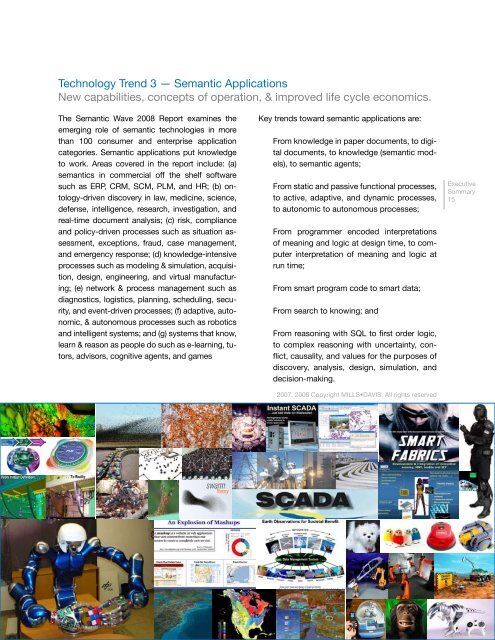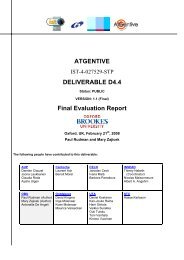Industry Roadmap to Web 3.0 & Multibillion Dollar ... - INSEAD CALT
Industry Roadmap to Web 3.0 & Multibillion Dollar ... - INSEAD CALT
Industry Roadmap to Web 3.0 & Multibillion Dollar ... - INSEAD CALT
Create successful ePaper yourself
Turn your PDF publications into a flip-book with our unique Google optimized e-Paper software.
Technology Trend 3 — Semantic Applications<br />
New capabilities, concepts of operation, & improved life cycle economics.<br />
The Semantic Wave 2008 Report examines the<br />
emerging role of semantic technologies in more<br />
than 100 consumer and enterprise application<br />
categories. Semantic applications put knowledge<br />
<strong>to</strong> work. Areas covered in the report include: (a)<br />
semantics in commercial off the shelf software<br />
such as ERP, CRM, SCM, PLM, and HR; (b) on<strong>to</strong>logy-driven<br />
discovery in law, medicine, science,<br />
defense, intelligence, research, investigation, and<br />
real-time document analysis; (c) risk, compliance<br />
and policy-driven processes such as situation assessment,<br />
exceptions, fraud, case management,<br />
and emergency response; (d) knowledge-intensive<br />
processes such as modeling & simulation, acquisition,<br />
design, engineering, and virtual manufacturing;<br />
(e) network & process management such as<br />
diagnostics, logistics, planning, scheduling, security,<br />
and event-driven processes; (f) adaptive, au<strong>to</strong>nomic,<br />
& au<strong>to</strong>nomous processes such as robotics<br />
and intelligent systems; and (g) systems that know,<br />
learn & reason as people do such as e-learning, tu<strong>to</strong>rs,<br />
advisors, cognitive agents, and games<br />
Key trends <strong>to</strong>ward semantic applications are:<br />
From knowledge in paper documents, <strong>to</strong> digital<br />
documents, <strong>to</strong> knowledge (semantic models),<br />
<strong>to</strong> semantic agents;<br />
From static and passive functional processes,<br />
<strong>to</strong> active, adaptive, and dynamic processes,<br />
<strong>to</strong> au<strong>to</strong>nomic <strong>to</strong> au<strong>to</strong>nomous processes;<br />
From programmer encoded interpretations<br />
of meaning and logic at design time, <strong>to</strong> computer<br />
interpretation of meaning and logic at<br />
run time;<br />
From smart program code <strong>to</strong> smart data;<br />
From search <strong>to</strong> knowing; and<br />
From reasoning with SQL <strong>to</strong> first order logic,<br />
<strong>to</strong> complex reasoning with uncertainty, conflict,<br />
causality, and values for the purposes of<br />
discovery, analysis, design, simulation, and<br />
decision-making.<br />
2007, 2008 Copyright MILLS•DAVIS. All rights reserved<br />
Executive<br />
Summary<br />
15<br />
2007, 2008 Copyright MILLS•DAVIS. All rights reserved
















